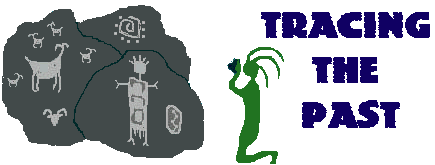Petrogylphs
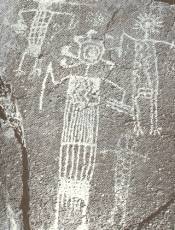  Every place has some sort of history. Places that were settled early often have more recorded history than places that were settled relatively late in our progression from east to west, then again it depends on what you mean by recorded history. Man was recording history long before he was setting pen to paper Every place has some sort of history. Places that were settled early often have more recorded history than places that were settled relatively late in our progression from east to west, then again it depends on what you mean by recorded history. Man was recording history long before he was setting pen to paper
There are a large number of petroglyphs in the surrounding mountains. No one knows for sure what they mean exactly. Where they the records of a people? Where they symbolic magic? A kind of show a successful hunt and you'll have one sort of thing. Whatever they were, they speak to us from centuries ago.
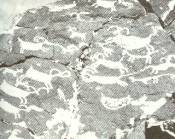  The Coso Range on the China Lake Naval Weapons Center has numerous examples of this ancient rock paintings. Unfortunately they are within the confines of the military base and they only have guided tours twice a year, spring and fall. These mountains are centrally located in what was the historic territory of the Western Shoshoni. In fact, Coso is the Shoshonean word for fire. There is indeed a great deal of evidence of volcanic activity in the area. Cinder cones, basaltic flows, and hot springs all can be found here. The Coso Range on the China Lake Naval Weapons Center has numerous examples of this ancient rock paintings. Unfortunately they are within the confines of the military base and they only have guided tours twice a year, spring and fall. These mountains are centrally located in what was the historic territory of the Western Shoshoni. In fact, Coso is the Shoshonean word for fire. There is indeed a great deal of evidence of volcanic activity in the area. Cinder cones, basaltic flows, and hot springs all can be found here.
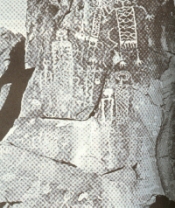  There are mainly two techniques for putting pictures on rock One is applying pigment to the surface by making a primitive "paint". These are uncommon in the Coso range. Long ago many of the rock surfaces in the area oxidized to dark brown or black finish. The second method involves chipping, pecking away at, or incising the surface until the lighter rock face is exposed. Usually the term refers to the size of the instrument. Chipping would have been done with a large rock hammer. Pecking was done with pointed rock, either holding it and striking the rock face or by placing it against the rock and hitting it with another larger rock. Incising was done with a narrow stone tool that was rubbed back and forth cutting a line. A variation of the second method was to chip or incise the outline of the design and then scrape or sand away the dark rock within the outlines with the edge of a sharp rock until the dark surface was abraded away. Pictures could be made using primarily one method or a combination. There are mainly two techniques for putting pictures on rock One is applying pigment to the surface by making a primitive "paint". These are uncommon in the Coso range. Long ago many of the rock surfaces in the area oxidized to dark brown or black finish. The second method involves chipping, pecking away at, or incising the surface until the lighter rock face is exposed. Usually the term refers to the size of the instrument. Chipping would have been done with a large rock hammer. Pecking was done with pointed rock, either holding it and striking the rock face or by placing it against the rock and hitting it with another larger rock. Incising was done with a narrow stone tool that was rubbed back and forth cutting a line. A variation of the second method was to chip or incise the outline of the design and then scrape or sand away the dark rock within the outlines with the edge of a sharp rock until the dark surface was abraded away. Pictures could be made using primarily one method or a combination.
  Interpretation of the figures is interesting. Since the rock art is placed on game trails and near springs, often in places that would help hide the hunter waiting in ambush it has been speculated that the pictures represent hunting magic. It is possible that they were made as part of a pre hunt ritual. It is equally possible they were made by the hunters themselves. We'll never know. Interpretation of the figures is interesting. Since the rock art is placed on game trails and near springs, often in places that would help hide the hunter waiting in ambush it has been speculated that the pictures represent hunting magic. It is possible that they were made as part of a pre hunt ritual. It is equally possible they were made by the hunters themselves. We'll never know.
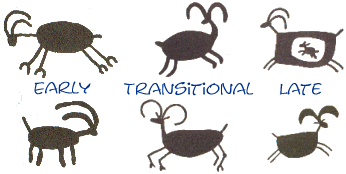 The images are divided by style or the manner in which the objects were rendered and period referring to the time the drawings were made. Naturalistic style shows objects that are realistic. Stylized objects are simplified but still recognizable. Abstract items most closely resemble decorative patterns. A fourth style is called pit and groove which are little circles arranged in lines or at random. The images are divided by style or the manner in which the objects were rendered and period referring to the time the drawings were made. Naturalistic style shows objects that are realistic. Stylized objects are simplified but still recognizable. Abstract items most closely resemble decorative patterns. A fourth style is called pit and groove which are little circles arranged in lines or at random.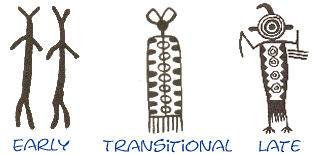 Early period images include sheep, atatls- which was a type of weapon, figures, and abstracts. The sheep are the only naturalistic images. Compared to later periods they are poorly done. Humans are stick figures. Transitional images show a shift in weapons to bows and arrows with the atatls becoming more stylized - possibly of a ceremonial nature. The first "medicine bags" appear and so do the first "shield" images. Sheep are abundant. The figures are becoming blocky anthropomorphic images with or without arms and legs. Late period images are more stylized and generally done with more skill than either of the early periods. The "boat-shaped" sheep is the dominant natural figure. Humans are elaborate ceremonial figures.
Early period images include sheep, atatls- which was a type of weapon, figures, and abstracts. The sheep are the only naturalistic images. Compared to later periods they are poorly done. Humans are stick figures. Transitional images show a shift in weapons to bows and arrows with the atatls becoming more stylized - possibly of a ceremonial nature. The first "medicine bags" appear and so do the first "shield" images. Sheep are abundant. The figures are becoming blocky anthropomorphic images with or without arms and legs. Late period images are more stylized and generally done with more skill than either of the early periods. The "boat-shaped" sheep is the dominant natural figure. Humans are elaborate ceremonial figures.
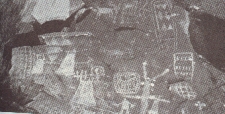  A very sad and tragic aspect of most things abandoned in the desert is the subsequent vandalism. Many examples of rock art have been defaced and some smaller examples have been removed. We must try to preserve these images for future generations so that they can also look at them and wonder about the lives and hopes of the people that made them. A very sad and tragic aspect of most things abandoned in the desert is the subsequent vandalism. Many examples of rock art have been defaced and some smaller examples have been removed. We must try to preserve these images for future generations so that they can also look at them and wonder about the lives and hopes of the people that made them.
Back to Mojaveolver Home Page


This page hosted by  Get your own Free Home Page
Get your own Free Home Page
| 